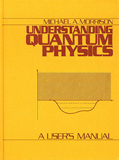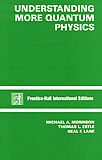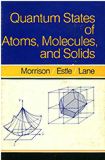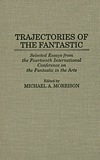Please click on the image
of any title for information and relevant links
|
Understanding
Quantum Physics: A User's Manual
|
I. WHAT'S IT ALL ABOUT?: A QUALITATIVE INTRODUCTION.
- 1. Introductory: Why Quantum Physics?
- 2. Into the Microworld: Duality and the Double
Slit.
II. STARTING FROM SCRATCH.
- 3. First Postulates: The State Function and
Its Interpretation.
- 4. An Illustrative Interlude: Wave Packets
in One Dimension.
- 5. Observables in Quantum Physics: A Pragmatist's
Approach.
- 6. A Quantum Equation of Motion: The Schrödinger
Equation At Last.
- 7. Simplifying Matters: The Time-Independent
Schrödinger Equation.
III. EXAMPLES, EXAMPLES, EXAMPLES.
- 8. States of a Particle in One Dimension I:
Mainly Piecewise-Constant Potentials.
- 9. States of a Particle in One Dimension II:
Mainly Continuous Potentials.
IV. TOOLS OF THE TRADE; MORE FORMALISM.
- 10. Operators in Quantum Mechanics I: The
Importance of Being Hermitian.
- 11. Operators in Quantum Mechanics II: To
Commute or Not to Commute.
- 12. Eigenfunction Expansions: How to Solve
Any Problem in Quantum Mechanics.
- 13. Altered States: The Great Measurement
Mystery.
- Appendixes.
- A. SI Units (The International System of
Units. B. Fundamental Constants in SI (and CGS) Units. C.
Order-of-Magnitude Estimates. D. Conversion Tables. E. Prefix
Dictionary. F. A User's Guide to Atomic Units. G. The Greek
Alphabet. H. Handy Trigonometric identities. I. Integrals
You Should Know. J. Integrals Involving the Gaussian Function.
K. Review of Complex Numbers. L. The Dirac Delta Function.
- Bibliography.
- Index.
- May, 1990: Prentice
Hall Engineering, Science & Math
See reviews at Amazon.com

|
| Understanding
More Quantum Physics: Quantum States of Atoms |
- 1. Recollections of Quantum Theory: A Survey
Chapter.
- 2. Solution of the Central Force Problem.
- 3. The One-Electron Atom.
- 4. The Wonderful World of Approximation Methods
(Time Independent).
- 5. More Approximation Methods (Time Dependent).
- 6. Spin.
- 7. Spin in the Hydrogenic Atom.
- 8. Introduction to the Quantum Mechanics of
the Multielectron Atom.
- 9. The Shell Model of the Atom.
- 10. Quantitative Approaches to Multielectron
Atoms.
- Appendices.
- May, 1991 by Prentice
Hall Engineering, Science & Math
See reviews at Amazon.com

|
| Quantum
States of Atoms, Molecules, and Solids |
This book, now out of print, augments the material in UMQP (on
quantum mechanics and atomic physics) with sections on molecular
and solid-state physics. Used copies are usually available at
abebooks.com,
at bibliofind.com,
and at albris.com
|
| Trajectories
of the Fantastic: Essays on Science Fiction, Horror, and Fantasy
in Fiction and Film |
The essays in this volume examine elements of the
fantastic in a variety of media. From the fiction of Toni Morrison,
Stephen King, and Chinua Achebe, to the rock songs of David Bowie,
the fantastic is seen as adaptable to any art form. In an accessible
manner, the contributors present fresh approaches to examining
the elements of the fantastic in literature, film, music, and
popular culture. The collection features an essay by Ursula K.
Le Guin and also includes an introduction and an essay by me entitled
``A Few Remarks About a Couple of Things: Hawks and Carpenter
Reconfigure Campbell.''
Contents
-- Introduction -- The Kingdom of the Fantastic
-- Changing Kingdoms by Ursula K. Le Guin -- Myth and Gender in
SF and the Gothic -- No Paradise to Be Lost: Deconstructing the
Myth of "Domestic Affection" in [Mary] Shelley's Frankenstein
by Rosemary Hathaway -- Using the Fantastic to Disrupt the Domestic:
An Examination of Marriage and Family in Angela Carter's Nights
at the Circus and Wise Children by Anna Katsavos -- Androgyny
and Difference in SF by Brian Attebery -- Androgynous Architecture:
Fantasies of Genre-Bending in the British Gothic Novel by Tanya
Gardiner-Scott -- Fantasy, Genre, and the Mainstream -- The Role
of the Fantastic in African Narratives: From Sundiata to Things
Fall Apart by William E. Mallory -- Behemyth Evolving: Whale/Ape/Rocket
by Joseph Andriano -- Apocalyptic Grotesque: The Day of the Locust
by Catherine Merrill -- Unraveling the Mystery of Toni Morrison's
Beloved by Beverly Skinner -- King as Classic: Excellence, Relevance,
Endurance by Edwin F. Casebeer -- The Seductive Doom in Young
Adult Fantasy by Greer Watson -- Fantastic Rock -- The Moorcock/Hawkwind
Connection: A Rock SF Multiverse by Michel Delville -- Future
Legends: David Bowie and Science Fiction by Maureen King -- Cinema
Fantastique I: Fantasy in Representation and Critique -- Architecture
as Duality and Fantasy: Mise en Scene and Boundaries in Tim Burton's
Films by Leonard G. Heldreth -- Beauty in the Beast: Technological
Reanimation in the Contemporary Horror Film by Mark J. Charney
-- Screening Desire: Posthuman Couplings in Atom Egoyan's Speaking
Parts and David Cronenberg's Videodrome by Rob Latham -- Cinema
Fantastique I: Twice Told Tales -- A Few Remarks about a Couple
of Things: Hawkes and Carpenter Reconfigure Campbell by Michael
A. Morrison -- Version/Inversion: Paranoia in Two Cases of Bodysnatching
by Michael Collins -- Greek Gifts: Vision and Revision in the
Two Nights of the Living Dead by Mary Pharr -- Index
Published in 1997 by Greenwood
Press
Reviews at Amazon.com
|
| A
Dark Night's Dreaming : Contemporary American Horror Fiction |
A Dark Night's Dreaming collects eight essays by well-known horror
critics such as Douglas E. Winter (author of Stephen King: The
Art of Darkness). The book opens with an introduction (by me and
my partner in crime, Tony Magistrale, in which we define the shape
of horror fiction today, illuminating the genre's narrative themes,
psychological and social contexts, and historical development.
The first full essay (by me) is on the nature and archetypes of
"horror at the end of the century" (picking up in 1980, where
Stephen King's Danse Macabre leaves off). There follow
essays devoted to Thomas Harris, Stephen King, Anne Rice, Peter
Straub, William Peter Blatty, and Whitley Strieber. The last essay
is on the interplay between horror fiction and film. Included
is an thorough 13-page bibliography of primary (emphasizing fiction
in the years 1988-94) and secondary sources.
Published in 1998 by The
University of South Carolina Press
Reviews at Amazon.com
|
|




